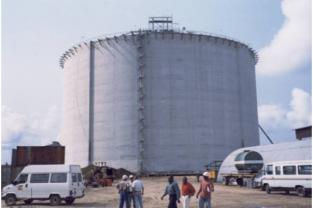Terrasol has been involved in the design of several LNG tank foundations in Nigeria, Egypt and India. With a storage capacity varying from 85,000 up to 150,000 m3, these pre-stressed concrete structures have large dimensions: 65 to 82 m in diameter and 35 to 40 m in height. Despite high loads transferred to the soil, strict criteria have to be complied with regarding the absolute and differential settlements.
The Nigerian project was located on soft clays and sands up to 45 m thick. The expected settlement was high: more than 1.3 m without soil treatment. Thus, it has been decided to build the tanks on slabs, after a pre-loading phase 7 years long with an embankment of 17.5m high. Finite element calculations have been performed to simulate the soil behaviour after the embankment removal (unloading) and to estimate soil settlements during construction and operation phases (including hydrotest).
Despite the duration and high load of the pre-loading, the residual settlements evaluation led to 12cm in the center and 5 cm on the edge of the tanks, which implied a differential settlement of 2/1000°. These predictions have been confirmed during the hydrotests.
The Egyptian project was located on more than 30 m thick soft clay and sand, laying on 30 m of dense sands. Beneath the dense sands, there was a layer of stiff clay. FE calculations pointed out that the settlements could reach 95cm with approximately 1/100° differential settlement without soil reinforcement. In this case a solution of shallow foundation was not suitable.
We analyzed 2 alternative solutions:
- Stone columns on 30m deep with a substitution ratio of 15%: long term settlements were estimated to 50 cm at the center and 35 cm on the edge. The differential settlement between the centre and the walls was reduced to 3.3/1000°, which was quite acceptable.
- Deep foundations: 300 piles (1200 mm diameter, 47 m long) per tank. Because of the load transfer to the deep clay layer, the long term settlements were reaching 21cm in the center with a differential settlement of 1.8/1000°, which was nevertheless acceptable. This solution has been chosen.
The Indian project was located on soft clays and sands with a thickness of 17m, leading to a settlement of 23cm at the center and a differential settlement of 2.1/1000°. However, because of bearing capacity limitations and liquefaction risks, a shallow foundation system could not be validated without soil reinforcement. Soil improvement methods by pre-loading or dynamic compaction, as well as deep foundation solutions, have been considered. The final soil reinforcement solution consisted in stone columns, with 1.500 columns per tank (17m deep, with a substitution ratio of 8.7%).
Terrasol’s achievements:
- Geotechnical synthesis
- Preliminary studies of different foundation solutions
- Design of soil reinforcement
- Settlement predictions, liquefaction risk analysis
- On-site follow-up
 Agent Access
Agent Access 




